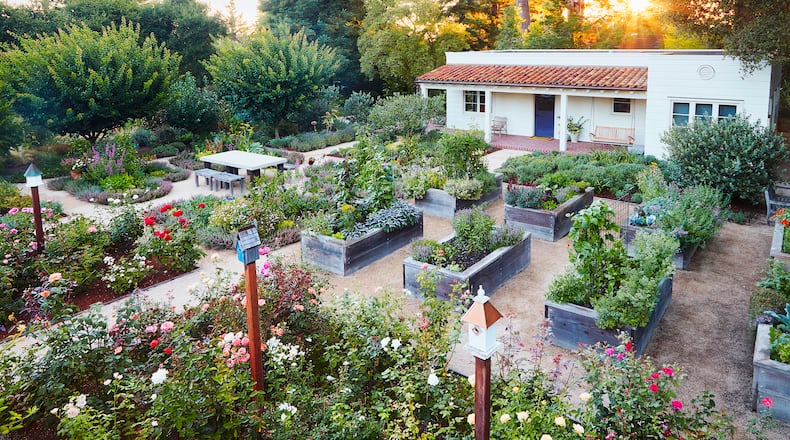In northern California, one family’s outdoor space brims and bubbles with natural attractions that you can see, hear, smell, touch and taste.
The first sound you hear when you walk into Elizabeth Horn and Zach Nelson’s garden is the whistling chatter of finches; the second is the gurgle of water from the fountain. Then the fragrance of rosemary greets you as you descend the steps into a loose grid of flowers, foliage and edibles. This immersive space is just what the couple wanted when they renovated their Hillsborough, California, property in 2012. “The goal was to turn it into a place of healing,” Horn says. “It’s impossible to be anything but relaxed here.”
Horn and Nelson created the 10,000-square-foot organic garden largely for their then-16-year-old daughter, Sophia, who has autism. “In my experience, eating local, clean, organic food is one of the best medicines for all children, especially those with health issues like autism,” says Horn, a filmmaker who has devoted herself to autism research for the past two decades. After installing raised beds, the couple brought in landscape designer Leslie Bennett, owner of Oakland-based Pine House Edible Gardens, to revitalize the soil with organic matter and plant an abundance of seasonally rotating fruit, vegetables and herbs, along with flowers like agastache, echinacea and yarrow. “They value the garden’s beauty and the food it produces equally,” says Bennett of her clients. “It makes for a really rich experience.”
Horn and Bennett work closely together to grow plants that Sophia likes to eat and look at, such as kale, Swiss chard and spinach, as well as purple varieties of echinacea, basil and shiso, because their colors have a soothing effect. Recently, the family introduced the finches, along with chickens, a bunny, outdoor cats and bees. “Nothing brings energy to a space like animals,” Horn says. “Everything happily coexists.”
Sophia is home-schooled, and often studies in this outdoor classroom while moving her feet across the soft gravel and rubbing lavender leaves between her fingers to release its calming scent. “Working in a garden is a clinically proven way to lower the anxiety that so often challenges people with this diagnosis,” says Horn, who invites researchers, clinicians, educators and families affected by autism over to share what they’ve learned.
“It’s a place to re-energize,” she says — or to simply unwind. “Sophia and I go there frequently throughout the day to walk around, smell the flowers, or sit and have tea. It’s like our own private heaven.”
How to create a sensory garden
1. Touch
For a tactile quality, mix in different textures, such as satiny flower petals and fuzzy leaves. To make them stand out, Bennett groups contrasting foliage together: lacy-topped carrots next to broad-leaved chard, for instance. Deeply grooved tree trunks and furry animals like bunnies count, too.
2. Sight
Choose a palette of colors you love, and blend flowers and foliage in gradations of those hues. Bennett opted for calming purples, apricots, pinks and yellows. Then enjoy it up close: The couple placed their table among the beds so they would be surrounded by beauty when they eat outside.
3. Scent
Fragrances both floral and herbal bring a garden to life vibrantly. This one is perfumed with roses, lilacs, lavender, citrus blossoms and sweet angel’s trumpets, as well as basil, mint and sage, which release their aromas when snipped or crushed.
4. Taste
Edibles can thrive in any size space — from a window box to a large plot. “If you grow food, plant flowers, too,” says Bennett; they attract pollinators and helpful insects. Horn and Nelson’s garden features blackberries, as well as a bed of purplish “Redbor” kale, “Tutti-Frutti” agastache blossoms and lacinato kale. The garden’s mint and roses also make for a lovely tea.
5. Sound
Add natural music with wind chimes or a water feature. Horn and Nelson’s garden includes a fountain situated below a hedge of rosemary by the entrance, welcoming visitors with a soft trickle. (Because the water is circulating, not stagnant, mosquitoes are not a problem.) Chickens cluck throughout the day, while wild birds and insects, attracted by pollinator plants, contribute their own seasonal soundtracks — if you grow them, they will come.
LET US HELP YOU!
Email your questions to askmartha@marthastewart.com, or send them to Ask Martha, c/o Letters Department, Martha Stewart Living, 805 Third Avenue, 25th floor, New York, NY 10022. Please include your full name, address, and daytime phone number. Letters and messages become the property of Meredith Corp. and may be published, broadcast, edited or otherwise used in any of its media. By submitting your questions to Ask Martha, you are agreeing to let us use your name and hometown in connection with our publication of your questions.
About the Author
The Latest
Featured

